|
Dresden, Germany was nearly obliterated seventy years ago in a
late-in-the-war incendiary attack. Four thousand five hundred years
prior, the Great Pyramids were raised on the plain of Giza. Jerusalem
was raised, razed, rebuilt, and traded hands many times in the past
three millennia. These cities have all been the sites of wondrous things
and terrible things and, like many old cities, the present is built on
the bones of the past. Nothing is forever, as we all know, but some
human behaviors are eternal.
Giza – The Ancient
CAIRO: Surging and
complex, hustle is the word here, from the moment you get hit upon
disembarking the airport and until you load your bags heading out. I
must have a big neon sign blinking on my head that says “American!
American! American!” which makes me an easy mark. We’re here with our
Chinese partners to do a weird little bit of business for Chinese mobile
phone manufacturers (I guess we’re all hustling, in a way).
The
Egyptian hustle continues all the way to the feet of the Great Pyramids
where everything is negotiable and the price is proportional to the
amount of each party’s desperation. Here, Sam the Camel Man gives me an
offer to ride Columbus the Camel; I’ll ride after Billy takes his turn
(and as soon as the camel wakes up). After a few moments of negotiation,
we arrive at a price, thirty bucks, for a cheap thrill and a photo.
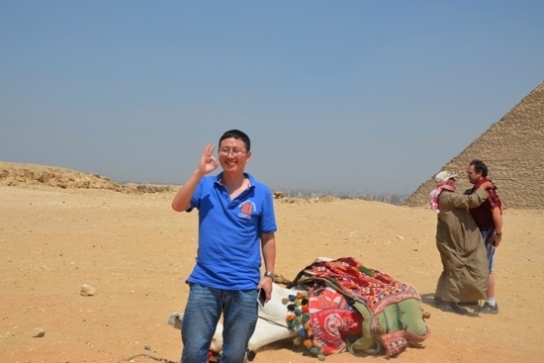
Billy, Camel, Sam, Me
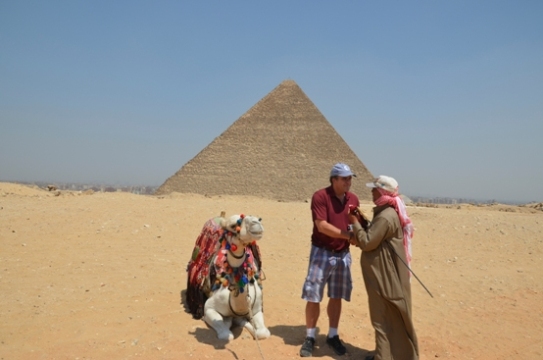
Done Deal with Sam the Camel Man

Columbus and Khafre
Since the revolution following the Arab Spring, the city of 20 million
people still has a long way to go for “recovery” if there is such a norm
here in this chaotic, noisy, gritty and ancient place which runs at a
pace that’s in sharp discord to quiet, sedate, ordered, clean and tidy
Germany, which I just departed.
The traffic is not unlike
Saigon or Siem Reap or a hundred other surging cities in the third
world: the flow is generally in the same direction, but the movements of
vehicles are more like surges of pulsing corpuscles, grinding together
in an knotted clump, bumping and pushing against each other. Trucks are
loaded beyond capacity. The scars on the cars bear witness to this
tumult. It is rare to see a bumper that is not bruised and scraped.
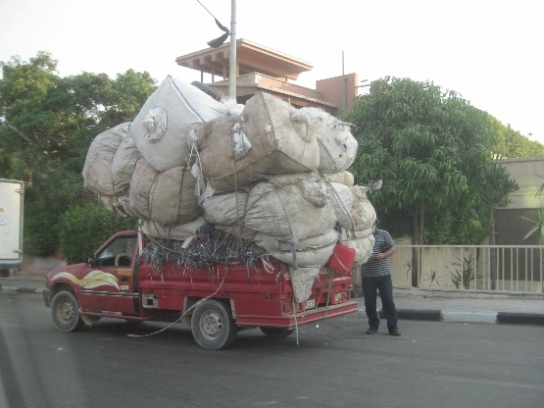
Loaded Up!
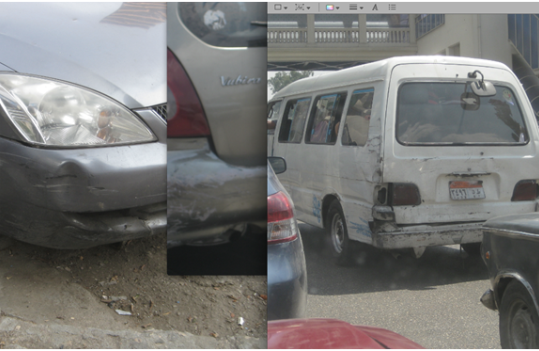
Bumped Bumpers
The
Necropolis of Giza lies twenty or so kilometers southwest of Cairo
proper and our hotel lies in lee of the pyramids. It’s odd to walk out
on the street and see taxis, cars, buses and motorbikes zipping by these
ancient monoliths, which have seen so much human history unwind over the
millennia.
The tourism industry is a bit chaotic and
even our host, Morris, seems a bit disoriented as we pull into the Giza
“welcome area,” a dusty and forlorn parking lot with strange crumpled
shapes of abandoned vehicle carcasses, bony horses, locals languishing
in the shade next to a relic of a Coca-Cola vending machine, having long
since dispensed its last cool bottle of refreshment.
We jump in
a two-person, horse drawn jitney of sorts and go about twenty feet when
our host starts the negotiations. Words heat up. The haggling goes back
and forth and it’s two-against one, but Morris stays steadfast. The
give-and-take lasts for nearly fifteen minutes. At long last, an
agreement is struck; Morris tells us later that he negotiated a 60
percent discount on the original price! It’s good to have local
representation in any negotiation. In spite of the deep reduction, our
guide Moneim a dark-skinned rail-thin fella sporting a
New York Yankees baseball cap, is affable and excited as we lurch
through the streets, his narrative as jagged as the ride is jarring.
We loop through the village that lines the great Cemetery of Giza. For a
short video tour, visit
https://www.youtube.com/watch?v=63gu9n_Pkoo
The oldest
Pyramid in Egypt dates to about 2630 BC and named after its entombed
Pharaoh, Djoser. It was designed and built by his
architect Imhotep. Following this work, the Great
Pyramids were built on a broad plateau, rising to over 140 meters above
the Giza plain. The biggest of the three main pyramids is
Khufu (or Cheops), named after the
Pharaoh who was entombed there. The other two pyramids in the complex
are Khafre, in the center and associated with the
Great Sphinx, and Menkaure, the smallest of
the three and situated in the southwest corner of the burial complex.
During the building heyday, some 10,000 workers, artisans, bakers,
tenders, families, administrators and others lived around the complex, a
public works project of an unimaginable magnitude.
The Pyramids
remain as one of the largest set of man-made buildings ever erected.
Curiously, aerial surveys of Pyramid complexes around the world reveal
that the arrangement is common, with a (coincidental?) resemblance to
the stars in Orion’s belt. But who knows?
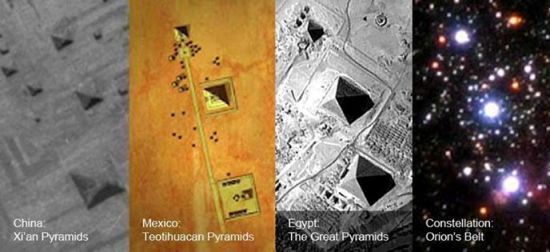
Pyramids and Orion’s Belt
Speaking of reaching towards the heavens, ancient Egyptians believed
that a part of the soul remains with the body. This part, the
ka, must be nourished and cared for in the
afterlife, hence the mummification and practice of burying the dead with
food and other necessities for the journey beyond. Relatively recent
excavations (1990) uncovered cemeteries for workers at the site. The
bodies were entombed in mud brick (not mummified) and buried with beer
and bread to feed their own kas.
One object that has attained a
sort of immortality is the Volkswagen Microbus. Cairo is home to what
must be the biggest population of VW Microbuses still in existence.
Hundreds, if not thousands of the wheezing air-cooled
four-cylinders—universally painted white (some with decidedly less paint
than others)—troll the streets of Cairo. According to our host, these
are all private vehicles with various routes (you better know where
you’re going). Hop-on, hop-off, the fare, depending, is a few
piastres and the bus stops appear to be wherever the driver is
inclined to pull over.
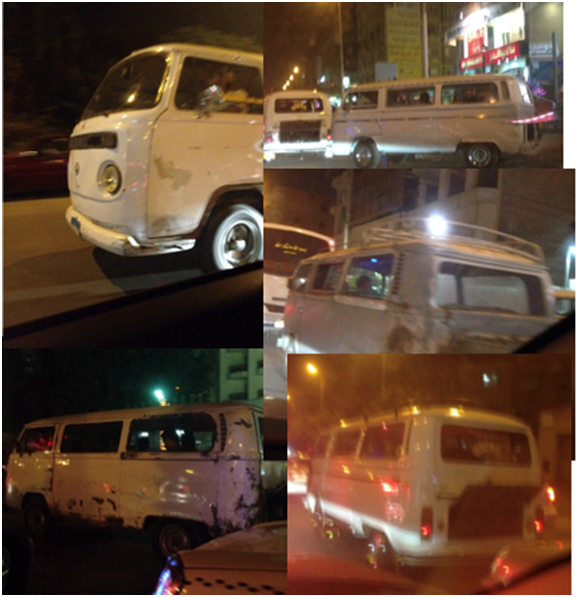
VW Microbuses
Our objective for this trip is to understand a bit about the Egyptian
wireless laws, administered by the National Telecommunications
Regulatory Telecom Authority (NTRA), (which has a Facebook page, by the
way). The mandate for the Authority is to protect the Egyptian spectrum,
much like the FCC in the US, as well as to protect the consumers from
inferior mobile phones. The market is strong for “2G” devices, which are
affordable and provide basic voice and text communications for the
Egyptian public. With 90 million people, the market is large for
manufacturers that can provide a value product. The NTRA has an
acceptance and a post-market testing program to make sure the imports
meet minimum necessary performance standards.
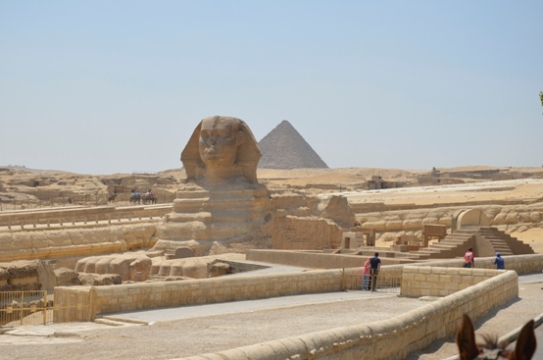
Sphinx and Menkaure
Finally, before we quit the land of the Pharaohs, our host treats us to
a cruise on the Nile (pronounced ‘Neel’) complete with the requisite
belly dancer, amply-figured according to local taste, apparently.

Belly Dancer
Jerusalem – The Contentious City
Flying from Egypt to Israel directly is possible on some carriers, but
my itinerary looped me via Amman, Jordan. The journey takes about 20
minutes longer than it should because flying through Israeli airspace is
restricted. Like most current airplanes the Royal Jordanian flight shows
the flight map on a video screen. The direct path is a dotted line
between Cairo and Tel Aviv and at first I thought we’d take the
proverbial shortest-distance-between-two points.
However it is
clear, after 10 minutes or so we were not taking a direct flight and our
path would East-Southeast across Sinai to take a hard left at Aqaba,
Jordan at the southern-most tip of Israel. Arabic cities are well-marked
on the flight map, but the display shows no Israeli city names, just
blank space. The following day, on the Amman-Tel Aviv flight, even our
destination is unnamed. This not-so-subtle denial of Israel’s existence
is, of course, all a byproduct endemic conflict in some of the most
contentious real estate on the planet.
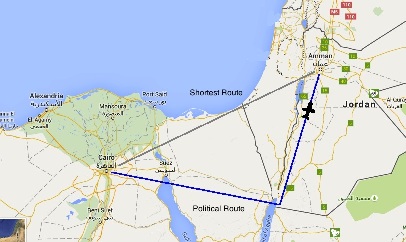
Flight Map
The complexities of tangled centuries of Middle East politics is not
easy to sort out. However, the end-result for all of us is the same:
dust-to-dust, as they say and the eastern side of the city is home to
two enormous cemeteries. The bones of many Muslims and Jews wash up
against the ancient walls. The Muslim cemetery rides right to the
Eastern wall, with the massive stones from Solomon’s times still holding
up the foundation and tall walls spilling down to a valley where the
Muslim cemetery ends and the Jewish cemetery begins, which coats the
shoulder of the Mount of Olives.
Issa and Me
Issa (Jesus or Joshua, appropriately enough—he says his western name is
Christophe) is my Palestinian driver who has raised four daughters and
one son. One of the daughters is an OBGYN, another is a PhD and the son
is studying to be a lawyer. They went to the esteemed Hebron University,
which was organized after the Israeli occupation of the West Bank after
the 1967 Six Day War as a place for Palestinian students to matriculate.
I met Issa at the Jerusalem train station. I had just disembarked and he
was standing next to his car, in the taxi queue, waiting for a fare and
I approached and said “Hello.”
He looked at me. “Where are you
going, sir?”
I replied. “I don’t know. I’ve never been here
before. I want to look around.” A shadow of exasperation crossed his
face, ‘oh boy this won’t be an easy 100 shekel fare.’
He shrugged
and threw up his arms. “Well, you can go to the Old City, the Mount of
Olives, Mount Scopus, from there you can see Jordan” He paused and
asked. “What do you want to do?”
I nodded. “All of it. I am only
here today. What do you suggest?”
A calculus kicked in and he
eased. “OK, sir. I will give you a tour of the two famous Mounts—Mount
of Olives and Mounst Scopus—Gethsame, the Garden of Tears, and a view
over the Old City.” He paused. “Then we go into the Old City, see the
famous gates, the Tomb of Mary, The Church of the Holy Sepulchre, and
some markets: The Muslim section the Christian section and the Jewish
section.”
“How much for that?” I asked. “And what about a return
to Tel Aviv?”
He responded. “For the tour, five hundred shekels.
If you want go back to Tel Aviv, uh, eight hundred, eight hundred
shekels for everything.” He said it firmly and with finality. Two
hundred bucks for the day. I thought a second. Yeah, I had that in
cash—I had taken out six hundred shekels at the airport and another four
hundred at the train station.
“So maybe five or six hours? Then
to Tel Aviv?” I looked at him. He nodded. “Deal. Let’s go.” We shook
hands and the tour commenced.
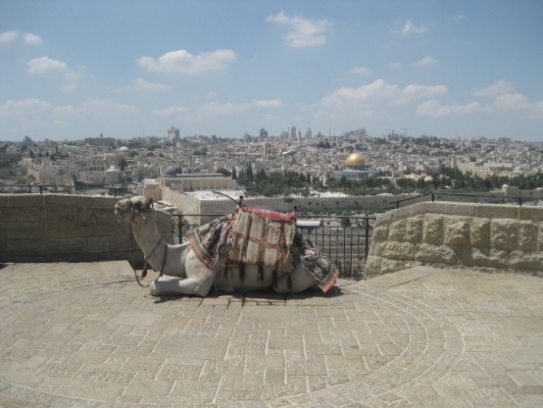
Camel Above the Old City. The golden Dome of the Rock.
I hopped in the back of his late-model Mercedes sedan and we started
off. He was a bit quiet and I didn't have a clue where we were going. I
pulled out my wallet and counted out the cash. “I’ll pay you now.” This
seemed to relax him a bit and we motored onto the freeway, drove a few
kilometers and then pulled off the highway to get some diesel. The
highway from the airport has a tall wall because it cuts through an Arab
neighborhood.
The off-ramp was a fortified checkpoint and we
pulled off the freeway into a small village. “Hmm, Issa said. This is
new.” The checkpoint was manned by a half-dozen Israeli Army with
assault weapons.
The sight of armed 20 year-olds would be a
normal sight around this perennially tense land.
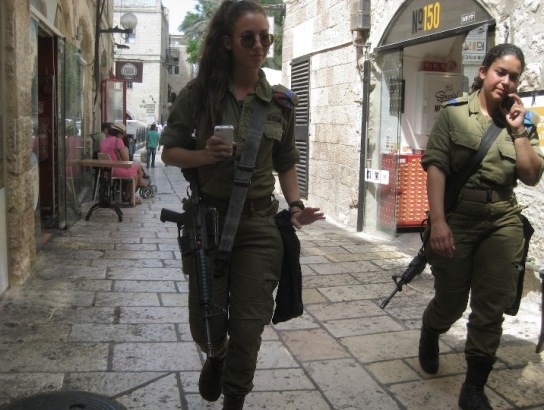
Girl Soldier. Automatic Rifle and iPhone
A bloody city, Romans, Christians, Crusaders, slaughtered their enemies
by the thousands over the thousand of years of the existence of this
place. Still, oddly, although it is a city of death and humans seeking
others’ annihilation, there is an energy here. It is like a center of
gravity of human faith that transcends rationality. It’s just a big rock
in a bigger desert, after all, but with so many remarkable solemn
places: the birthplace of Mary, King David’s Tomb, a vast Muslim
cemetery, the Wailing Wall, the Dome of the Rock.
The corridors
under the old City are lined with shops for tourist and travel. The
Christian, Muslim and Jewish sections lie along side each other.
Ordinary persons living ordinary lives in an extraordinary setting.
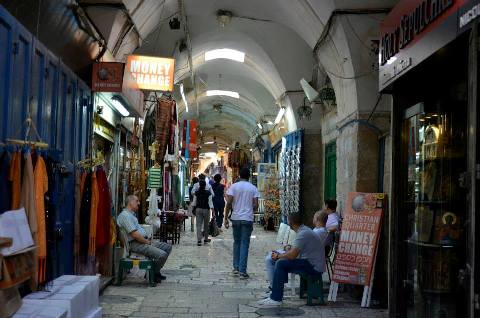
Jerusalem Market
Issa’s insights were very valuable, as a Gentile who only knows the Holy
Land from Catechism lessons learned long ago and largely forgotten. The
names ring, though, still. Here, from the base of the Old City, the
graves of Muslims press against the wall while across the valley,
towards the Mount of Olives, lie the bones of Jewish faithfully
departed. Both faiths eternally bound together in the same dust.

Muslim Bones and Jewish Bones
Issa and Kuwait City
After a tour of the sites, Issa takes me northwest towards Tel Aviv, the
lightning tour of the Holy City now finished. By now, having shared some
talking and walking and hummus, he’s relaxed and tells me how Saddam
Hussein did him a favor a few years back.
Seems he was working
in Kuwait City as a driver, delivering medicines and ferrying patients
around for a hospital. “I take the medicine and give it to the company
there.” He says.
But Issa hated working in Kuwait and was fussing
about it to his boss, George, a fellow Palestinian who managed the car
service. One of the things he missed was a cold beer.
“I tell
him, I dreenk, but not that much. But I dreenk…alcool. Everything they
have here, but no beeerh. He told me…nobody dreenk that much here. I
tell, look, I know how to make the beer, but this stuff I need, he
brings this to me from the British…I think they how to make the beeerh.”
Hops?
“Yaasss! And I start to make, a lot. One day he visit
to me my place. ‘ah you have a cold beeerh’ I say ‘yes yes’ and we start
to dreenk together.“
“Now it was the day off for us, Thursday and
Friday. I tell my friend George ‘This time I go to Cyprus and I
don’t want to come back!’
I said ‘that’s eet’”
‘But you signed contract!’ George told me.
“You must!”
“I told him ‘I don’t care. I don’t want to come here
again. I don’t want that.’
When was this?
‘This was in
1989.”
“George, my friend told me ‘Look you to go Cyprus now, go
there, have a rest. Take Thursday and Friday and take Saturday off and I
make for you paper to come into Monday for work.’”
“I say ‘OK, I
see. Make what you want.’ I go to Cyprus. So I go to Larnaca.”
“I
leave Kuwait in Wednesday. Five o’clock. I go to Cyprus; I have a friend
in Cyprus. I told him I want to to dreenk something, to eat something.
He’s from Lebanon he says ‘I will take Lebanese restaurant. When we move
from his apartment, it was twelve O'clock. We go to this restaurant, we
sit, we eat, we dreenk, we joke, we dreenk, we this. Tch. I look in the
TV! Something shooting! A war! I read ‘Iraq occupy the Kuwait!’ Tch. Ah!
I look in the TV. I think this ees film. I look, I move my face, I don’t
care. I theenk this ees film. I don’t think so this is the news.”
“But I understand the Greek. I move my face again. Ahh! I don’t say
anything. I go to the telephone, I call my friend in Kuwait, George. He
answer! I ask him ‘What’s happening in the Kuwait? You see bombs, you
hear bombs,’ he say’s ‘I hear bombs, many bombs, maybe this is something
they have from the Amir, he married his son or something?’ I tell him
‘What’s married?! Iraq! He occupy the Kuwait! Saddam in the Kuwait!’ He
said ‘ Are you foolish?’ I say ‘Not foolish.’ Then cut the telephone.”
“I tried to call, I tried to call. That’s it. No more telephone.”
So you couldn’t go back?
“No! I don’t go back to Kuwait, big
problem for me, if I go back, I am Palestinian. Tch. I can't go back,
but I didn’t want anyway.“
He smiles. “So when Saddam occupied
Kuwait. I was lucky.” [i]
Dresden: The Unintended
Necropolis
“Through the roar of the flames streaming far
and wide, the groans of the falling victims were heard; such was the
height of the hill and the magnitude of the blazing pile that the entire
city seemed to be ablaze; and the noise - nothing more deafening and
frightening could be imagined. “-Josephus Flavius [1]
These words were written about Roman the destruction of the Temple
of Jerusalem in AD 70; they could very well have described the horrid
nights of February 13-14 1945 which saw Dresden Germany turn into a
flaming Necropolis. Germany was on its knees, retreating and largely
unable to defend its cities from waves of US and British bombers.
This city has been rebuilt, remarkably, from mountains of rubble.
Kurt Vonnegut, who was held prisoner-of-war in Dresden up until the end
of the war adapts his memories of the events into his novel
Slaughterhouse Five,
wherein the fictional Billy Pilgrim jumps time and space. Vonnegut
commented that the Firebombong of Dresden “was so meaningless, finally,
that one one person on the entire planet got any benefit from it. I am
that person. I wrote this book which earned me a lot of money and made
my reputation, such as it is. One way or another, I got two or three
dollars for every person killed. Some business I’m in.” [2]
The
decision to destroy Dresden so late in the war was hotly debated as
Germany had largely been beaten. Dresden did have some rail yards and
was one of the last largely undamaged cities in Southern Germany, but
was not really critical to the war effort. The firebombing was a
massacre that killed anywhere from 30,000 to 100,000 people in about 24
hours. The numbers are disputed, inflated, perhaps on the high end.
Suffice it to say, it was almost all a civilian population that was
targeted. The debate over the reasons continues.
Some of the
reasons that have been debated included using brute force destruction to
demoralize the populace, boost morale in the UK or as retribution for
Hitler’s raids on London (Coventry, notably).
In any event,
World War II was a pivot point in warfare. wherein civilian populations
had always been targets of mass-extermination, such as the 1099 Crusades
when tens of thousands of Muslims and Jews, fighting together, were
massacred inside the gates of the Old City of Jerusalem by marauding
Christians.
___________________
[1]
http://www.eyewitnesstohistory.com/jewishtemple.htm
[2] The Firebombing of Dresden. P. 530
But now, whole cities could be destroyed from the skies. This novel
“philosophy” of extinguishing cities ultimately led to the use of atomic
bombs over Hiroshima and Nagasaki. 100,000 people could be killed in
once shot.
What is remarkable about Dresden is the restoration and rebirth that
came after the war, most rapidly after the reunion of East and West
Germany and the expiration of the German Democratic Republic. Funds for
restoration flowed from the West, monies raised included efforts by UK
and US flyers that had participated in the destruction.
The most
amazing restoration was completed just over ten years ago. The utterly
destroyed Frauenkirche (Church of Our Lady) was rebuilt to its original
design, at a cost of some €180 million. Lying as a ruin for 45 years,
reconstruction was undertaken in earnest in the 1990s with the project
gaining momentum after the fall of the Berlin Wall and the reunification
of the two Germanys.
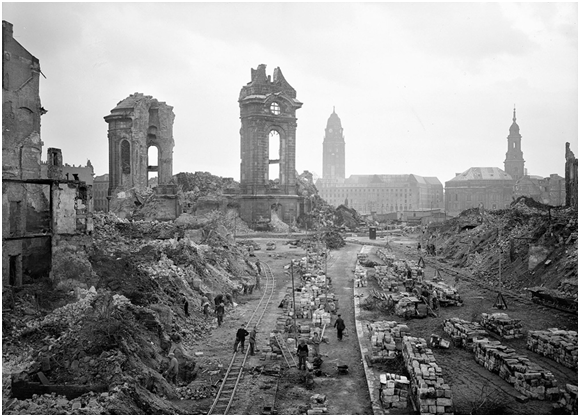
Dresden Frauenkirche (Church of Our Lady) after the Firebombing
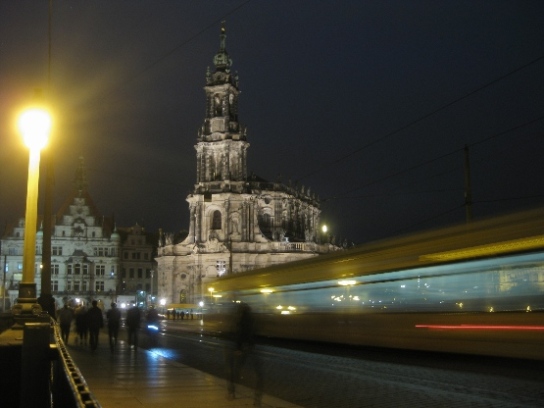
Dresden Rebuilt
Home
A mother's friend, a WWII war bride from
China, was laid to rest shortly after I returned to Washington. She was
interred with her late husband at Arlington National Cemetery, on the
grounds of the former residence of General Robert E. Lee. The cemetery
was sited there as an eternal “tribute” to Lee's legacy wreaked by
carnage of the American Civil War. With so many graves practically
hugging the Custis' family home, Lee never returned.

Arlington Cemetery
All cities have one thing in common, humanity continuing to build in
these places where we all eventually will return to the soil.
___________________
[i] George turned out to be fine. He made his way to Cairo a few
days later, but had no money or way to get out. Issa flew to Cairo to
help his friend. George is now back in Israel.
|

